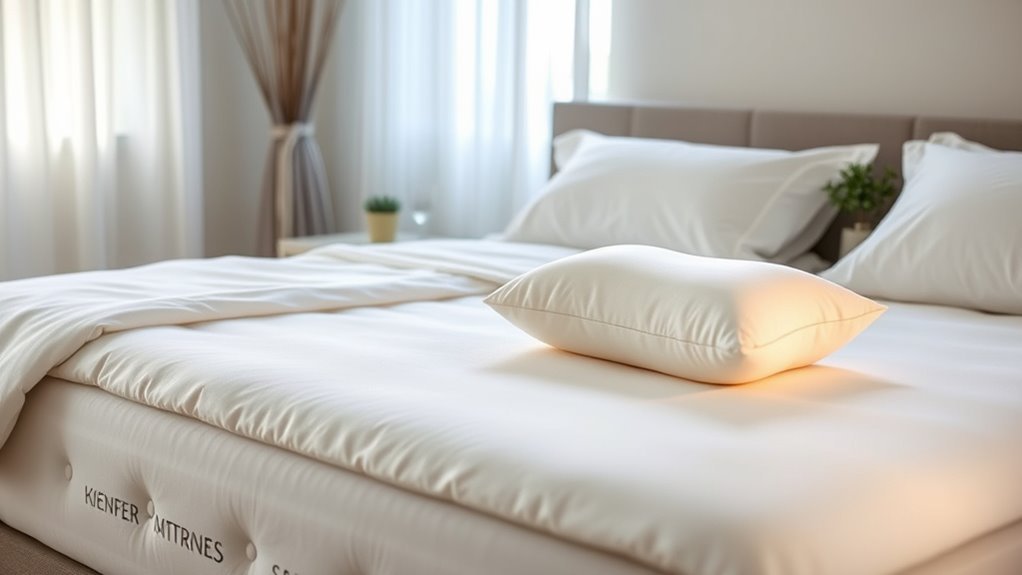If your mattress is too soft and causing neck pain as a back sleeper, assess its support first. Look for sagging or dips that disrupt alignment. You might consider adding a firm mattress topper to enhance support and relieve pressure points. Adjusting your sleeping position and using supportive pillows can also make a difference. Prioritizing these adjustments can greatly improve comfort and reduce pain. Explore more options to create a restful sleep environment tailored to your needs.
Understanding the Importance of Mattress Firmness for Back Sleepers
When it comes to choosing a mattress, understanding firmness is essential, especially for back sleepers. The right firmness level supports your spine’s natural alignment, alleviating pressure points and reducing discomfort. Different mattress types, such as memory foam, innerspring, and latex, offer varying levels of support and responsiveness. For back sleepers, a medium-firm mattress often strikes the perfect balance, ensuring your hips and shoulders sink just enough while maintaining spinal alignment. Your sleep posture greatly influences your overall comfort and health, so it’s vital to select a mattress that caters to your unique needs. Remember, investing in the right firmness not only enhances your sleep quality but also grants you the freedom to wake up refreshed and ready to embrace the day.
Assessing Your Current Mattress for Support Issues
To assess your mattress for support issues, start by checking for any sagging areas that could be compromising your spine’s alignment. Next, evaluate the firmness levels to see if they match your needs as a back sleeper. Identifying these factors is essential for ensuring a restful night’s sleep and preventing discomfort.
Check for Sagging Areas
A essential step in determining if your mattress is truly providing the support you need is checking for sagging areas. Start with a proper inspection: lie down on your back and assess whether your body sinks too deeply into the mattress. Pay attention to any noticeable dips or uneven surfaces. These sagging areas can lead to improper spinal alignment, aggravating neck pain for back sleepers. Regular mattress maintenance is important, so if you notice any sagging, consider rotating the mattress or adding a supportive layer. If issues persist, it might be time to invest in a new mattress that better supports your sleeping posture. Remember, your comfort and health depend on a well-supported sleep environment.
Evaluate Firmness Levels
After checking for sagging areas, the next step in ensuring your mattress meets your needs is evaluating its firmness levels. Firmness can greatly impact your spinal alignment and overall comfort, especially for back sleepers with neck pain. Consider the mattress materials—memory foam, latex, or innerspring—all have different firmness properties. You’ll want to assess how these materials respond to your body weight and shape. Think about your personal preferences, too; some people prefer a firmer feel while others may need a bit of cushioning. Lie down in your usual sleeping position for at least 15 minutes, paying attention to any pressure points or discomfort. This evaluation will help you decide if a firmer option is necessary for better support.
The Benefits of Using a Mattress Topper
Using a mattress topper can greatly enhance your sleeping experience by providing extra support and comfort. This additional layer can help improve spinal alignment, reducing strain on your back while you sleep. If your mattress feels too soft, a topper might just be the solution you need for a better night’s rest.
Enhanced Support and Comfort
When you find your soft mattress isn’t providing the support your back needs, a mattress topper can be a game-changer. These sleep accessories come in various mattress materials, such as memory foam, latex, or gel-infused options, allowing you to customize your comfort level. By adding a topper, you can enhance support without the need to invest in a new mattress. It effectively redistributes your body weight, alleviating pressure points and increasing overall comfort. This upgrade not only extends the life of your mattress but also promotes better sleep quality. With the right topper, you can enjoy a more restful night, freeing yourself from discomfort and waking up rejuvenated and ready to take on the day.
Improved Spinal Alignment
A quality mattress topper can greatly improve spinal alignment for back sleepers. By using a topper, you can enhance your sleep experience and alleviate neck pain caused by poor spinal curvature. Here’s how it can help:
- Supports Natural Curvature: It encourages the spine’s natural alignment, reducing strain on your back.
- Distributes Weight Evenly: This helps relieve pressure points, making sleep more comfortable.
- Enhances Alignment Techniques: A topper can provide targeted support for your neck and shoulders.
- Improves Overall Sleep Quality: Better alignment means deeper, more restorative sleep.
Investing in a mattress topper not only promotes proper spinal alignment but also gives you the freedom to enjoy restful nights without discomfort. You deserve a peaceful sleep!
Exploring Different Types of Mattress Toppers
If you’re struggling with a soft mattress that leaves you feeling unsupported, exploring different types of mattress toppers can provide a practical solution. Memory foam toppers contour to your body, offering excellent support and pressure relief, which can be particularly beneficial for back sleepers. They adapt to your shape, helping to alleviate neck pain and improve spinal alignment. Alternatively, gel-infused toppers combine the benefits of memory foam with cooling properties, making them ideal if you tend to overheat at night. These toppers enhance comfort while maintaining support, allowing for a more restful sleep. By choosing the right topper, you can transform your soft mattress into a more supportive sleep surface, promoting better sleep quality and overall well-being.
Adjusting Your Sleeping Position for Better Alignment
Although you may not realize it, adjusting your sleeping position can considerably impact your spinal alignment and overall comfort on a soft mattress. By being mindful of your sleeping habits, you can enhance your body’s alignment and reduce neck pain. Here are four adjustments to take into account:
- Keep your knees elevated: Use a pillow under your knees to relieve pressure on your lower back.
- Align your spine: Confirm your head, neck, and spine are in a straight line to prevent strain.
- Shift your arms: Avoid tucking them under your head; instead, keep them alongside your body.
- Experiment with angles: Slightly adjust your torso position to find the most comfortable alignment.
Making these adjustments can lead to a more restful sleep and alleviate discomfort.
Incorporating Pillows for Neck Support
Proper alignment isn’t just about your spine; your neck also plays an essential role in achieving a restful sleep, especially on a soft mattress. By incorporating the right pillow types, you can enhance your neck alignment and alleviate discomfort. Here’s a quick guide to help you choose the best options:
| Pillow Type | Description | Benefits |
|---|---|---|
| Memory Foam | Contours to your neck | Supports natural curve |
| Cervical | Designed for neck support | Maintains proper alignment |
| Adjustable | Fill can be added/removed | Customizable height |
| Latex | Firm yet responsive | Offers good support |
Selecting the right pillow can make all the difference in how you feel upon waking. Consider your preferences and sleep style to find your perfect fit.
Evaluating Alternative Sleep Solutions
When your soft mattress leaves you feeling achy, exploring alternative sleep solutions can be a game changer. Consider these options to enhance your comfort and support:
- Memory Foam Toppers: They adapt to your body shape, providing better spinal alignment.
- Latex Mattresses: Made from alternative materials, they offer firmer support while being breathable.
- Adjustable Bed Frames: Elevating your head can relieve pressure on your neck and back, improving sleep hygiene.
- Hybrid Mattresses: Combining foam and innerspring, they deliver balanced support and comfort.
Evaluating these alternatives can empower you to reclaim restful nights. Prioritize your well-being and embrace solutions that align with your needs, helping you wake up refreshed and free from discomfort.
Tips for Maintaining a Pain-Free Sleep Environment
To guarantee you consistently experience a pain-free sleep environment, it’s essential to focus on several key factors that influence your comfort. Start with your mattress; make sure it offers adequate support for your spine and neck. Consider using a medium-firm mattress topper if your current mattress is too soft. Additionally, keep your bedroom cool, dark, and quiet to promote restful sleep. Invest in quality pillows that align with your neck’s natural curvature, aiding in pain management. Regularly change your bedding to maintain hygiene and comfort. Finally, establish a relaxing bedtime routine to signal your body it’s time to wind down. By paying attention to these elements, you’ll create a sleep environment that fosters freedom from discomfort and supports restful nights.
Frequently Asked Questions
Can a Mattress Be Too Firm for Back Sleepers?
Yes, a mattress can definitely be too firm for back sleepers. While back sleepers need support, excessive firmness can lead to pressure points, causing discomfort in your lower back and spine. Ideally, a balance of mattress firmness is essential—enough support to keep your spine aligned while still allowing for some contouring. If you’re feeling sore or stiff in the morning, it might be worth exploring a slightly softer option for better comfort.
What Materials Are Best for Mattress Toppers?
What if the right mattress topper could transform your sleep? For ideal comfort, consider memory foam and latex options. Memory foam conforms to your body, providing excellent pressure relief, while latex options offer a more responsive feel with natural breathability. Both materials can enhance your mattress’s support, especially for back sleepers. When selecting, think about your personal preferences for firmness, durability, and temperature regulation to find the perfect match for a restful night.
How Often Should I Replace My Mattress?
You should replace your mattress every 7 to 10 years, depending on its lifespan and your personal needs. Look for signs of replacement, like sagging, lumps, or discomfort during sleep. If you’re waking up with aches or allergies, it might be time for a change. Investing in a new mattress can greatly enhance your sleep quality, allowing you to wake up refreshed and ready to embrace each day with freedom and energy.
Are Adjustable Beds Beneficial for Back Pain?
Yes, adjustable beds can provide significant benefits for back pain. By allowing you to elevate your head or legs, they help align your spine and reduce pressure on sensitive areas, leading to better pain relief. This customizable support can alleviate discomfort, making it easier for you to find a position that suits your individual needs. Plus, the freedom to adjust your bed can enhance your overall sleep experience, promoting restorative rest.
Can Sleeping Positions Affect Neck Pain Severity?
Sleeping positions can greatly affect neck pain severity. In fact, studies show that over 60% of people experience neck pain related to improper sleep alignment. When you sleep on your back or side, maintaining proper neck alignment is vital. If your head’s tilted too much, it can strain muscles and lead to discomfort. It’s important to choose a supportive pillow and mattress to help you find that perfect balance and achieve restful, pain-free sleep.



